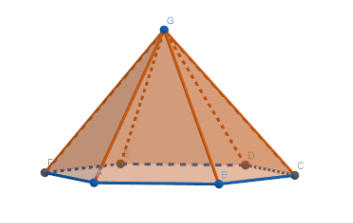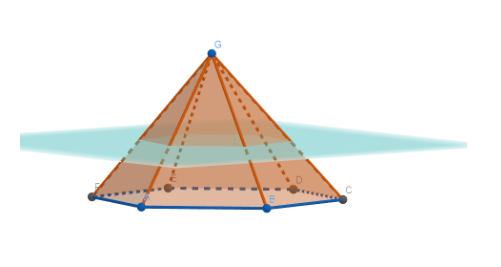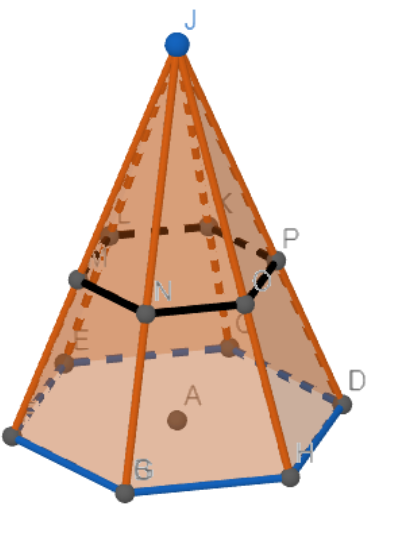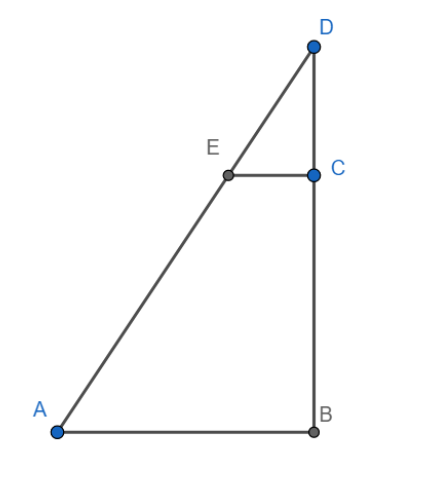
A pyramid is cut by a plane parallel to its base at a distance from the base equal to the two-thirds of the length of the altitude. The area of the base is 18 square units. Find the area of the section determined by the pyramid and the cutting plane.
[a] 1
[b] 2
[c] 3
[d] 6
[e] 9
Answer
513.9k+ views
Hint: Use the fact that the ratio of areas of two similar figures is equal to the square of their corresponding side lengths. Assume that the length of a side of the base is equal to x. Find the length of the corresponding side of the section of the pyramid. Hence determine the ratio of the sides and hence determine the ratio of the areas and hence the area of the section.
Complete step-by-step answer:
Let the distance of the centre of the base from a vertex be x.

Consider the section of the pyramid as shown

Visualising the section due to the plane in the above diagram

As is clear the section is also a polygon similar to the base of the pyramid.
Join the top of the pyramid with the centre of the base and the centre of the base with the vertex and the centre of the section with the corresponding vertex in the section.
This will form a triangle as shown below

Here D is the top of the pyramid, C the centre of the section, B the centre of the base, A the vertex of base and E the corresponding vertex of the section.
Since the plane cuts at two-thirds the length of the altitude from the base, we have
Now, in triangle ABD, we have EC||AB.
Hence, we have
Hence, we have
Hence, we have
Since EC is a length in the section and AB the corresponding length in base polygon
Hence, we have
Given the area of the base = 18
Hence, we have
Hence option [b] is correct.
Note: [1] The above question uses the property that the ratio of areas of two similar figures is equal to the squares of the ratio of the corresponding lengths in the figures. This is a consequence of the fact that the area is obtained as a product of lengths in the figure and since the lengths are proportional, the ratio of areas is the square of the ratio of corresponding lengths in the figures.
Complete step-by-step answer:
Let the distance of the centre of the base from a vertex be x.

Consider the section of the pyramid as shown

Visualising the section due to the plane in the above diagram

As is clear the section is also a polygon similar to the base of the pyramid.
Join the top of the pyramid with the centre of the base and the centre of the base with the vertex and the centre of the section with the corresponding vertex in the section.
This will form a triangle as shown below

Here D is the top of the pyramid, C the centre of the section, B the centre of the base, A the vertex of base and E the corresponding vertex of the section.
Since the plane cuts at two-thirds the length of the altitude from the base, we have
Now, in triangle ABD, we have EC||AB.
Hence, we have
Hence, we have
Hence, we have
Since EC is a length in the section and AB the corresponding length in base polygon
Hence, we have
Given the area of the base = 18
Hence, we have
Hence option [b] is correct.
Note: [1] The above question uses the property that the ratio of areas of two similar figures is equal to the squares of the ratio of the corresponding lengths in the figures. This is a consequence of the fact that the area is obtained as a product of lengths in the figure and since the lengths are proportional, the ratio of areas is the square of the ratio of corresponding lengths in the figures.
Latest Vedantu courses for you
Grade 11 Science PCM | CBSE | SCHOOL | English
CBSE (2025-26)
School Full course for CBSE students
₹41,848 per year
Recently Updated Pages
Master Class 9 General Knowledge: Engaging Questions & Answers for Success

Master Class 9 English: Engaging Questions & Answers for Success

Master Class 9 Science: Engaging Questions & Answers for Success

Master Class 9 Social Science: Engaging Questions & Answers for Success

Master Class 9 Maths: Engaging Questions & Answers for Success

Class 9 Question and Answer - Your Ultimate Solutions Guide

Trending doubts
What is the difference between Atleast and Atmost in class 9 maths CBSE

Describe the factors why Mumbai is called the Manchester class 9 social science CBSE

Write the 6 fundamental rights of India and explain in detail

Distinguish between Conventional and nonconventional class 9 social science CBSE

What are the major achievements of the UNO class 9 social science CBSE

One of the best solutions to get rid of nonbiodegradable class 9 chemistry CBSE




